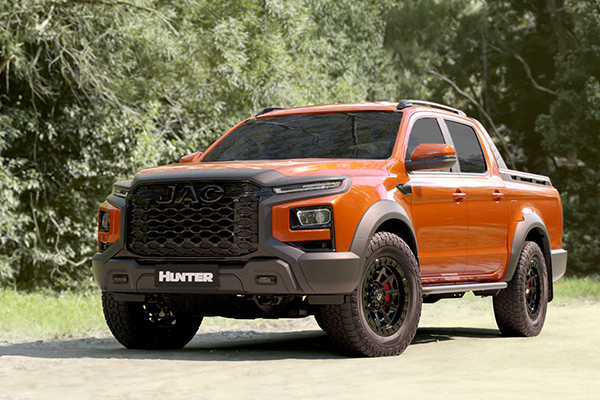JAC Hunter PHEV revealed in Australia as mega-performance utility
Besides announcing the expansion of the diesel-powered T9 range, JAC also confirmed the impending arrival of a souped-up version of its dual-cab ute, which combines electric and combustion power to produce power and torque numbers that easily eclipse pretty much every other body-on-frame ute currently available – and a sizable number of proper performance cars as well.
To be dubbed the JAC Hunter, the plug-in hybrid pickup is essentially a T9 with the regular diesel powertrain swapped out in favour of a turbo petrol generator and a dual-motor electric driveline. The figures are eye-watering. The combined output of its electric motors – one on each axle – tallies a respectable 385kW, which is 93kW more than the current ute performance king, the Ford Ranger Raptor.
ADVERTISEMENT
Meanwhile, the Hunter’s monstrous 1,000Nm torque peak not only comes close to double what the Raptor produces, but it also eclipses the 882Nm of the now-discontinued supercharged V8 RAM TRX. In comparison to other fast four-doors, the JAC Hunter PHEV even offers 100Nm more torque that what the $410,000 Mercedes-AMG GT 63S E Performance produces, a fact that will probably bruise more than a few German egos. You’d better strap your loads down extra tight.
That giant-slaying performance is all sourced from a 31.2kWh lithium-ion phosphate battery, which can either be charged from a regular wall outlet, a DC fast-charger or the onboard 2.0L turbo petrol engine – which acts solely as a generator, and doesn’t drive the wheels. That battery supplies enough energy, JAC claims, to drive for up to 100km before the combustion engine needs to be started up, though the company has yet to detail its full range when petrol power is switched on, or reveal its combined-cycle fuel consumption number.
However, JAC has confirmed that the Hunter will, like many other plug-in hybrids and electric vehicles, be able to offload some of its stored electrical energy via an integrated household power outlet, allowing workers to keep tools charged up when working remote sites or at locations that have yet to be connected to grid power, without having to bring along a separate genset.
As with its fuel economy, JAC has yet to announce the Hunter’s other critical metrics – payload and towing capacity – though the company has indicated that it is chasing a one-tonne payload and 3,500kg tow capacity for its first PHEV performance ute.
Externally, the JAC Hunter will largely resemble its purely combustion-powered sibling the T9, while internal differences will largely be limited to a different transmission selector and other minor trim details. As for its price and more precise specifications, we’ll need to wait until closer to the JAC Hunter’s projected early-2026 arrival for those to be revealed.
-
ADVERTISEMENT
-
ADVERTISEMENT


